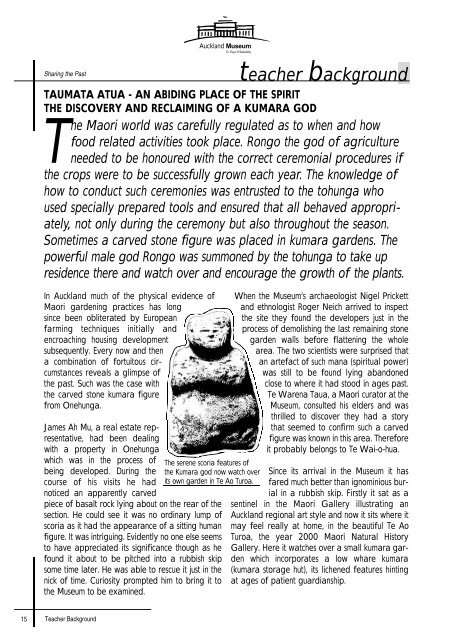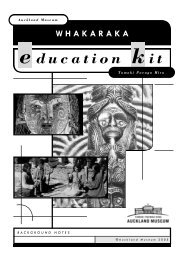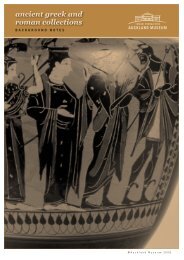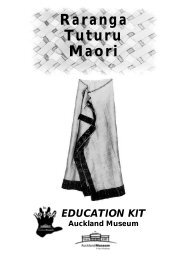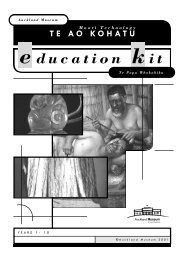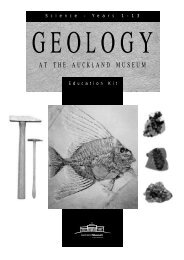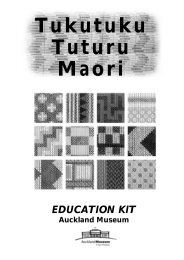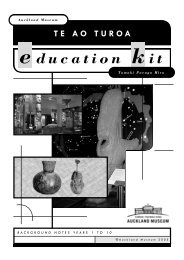You also want an ePaper? Increase the reach of your titles
YUMPU automatically turns print PDFs into web optimized ePapers that Google loves.
Sharing <strong>the</strong> Past<br />
15 Teacher Background<br />
<strong>Auckland</strong> <strong>Museum</strong><br />
Te Papa Whakahiku<br />
TAUMATA ATUA - AN ABIDING PLACE OF THE SPIRIT<br />
THE DISCOVERY AND RECLAIMING OF A KUMARA GOD<br />
The Maori world was carefully regulated as to when and how<br />
food related activities took place. Rongo <strong>the</strong> god of agriculture<br />
needed to be honoured with <strong>the</strong> correct ceremonial procedures if<br />
<strong>the</strong> crops were to be successfully grown each year. The knowledge of<br />
how to conduct such ceremonies was entrusted to <strong>the</strong> tohunga who<br />
used specially prepared tools and ensured that all behaved appropriately,<br />
not only during <strong>the</strong> ceremony but also throughout <strong>the</strong> season.<br />
Sometimes a carved stone figure was placed in kumara gardens. The<br />
powerful male god Rongo was summoned by <strong>the</strong> tohunga to take up<br />
residence <strong>the</strong>re and watch over and encourage <strong>the</strong> growth of <strong>the</strong> plants.<br />
In <strong>Auckland</strong> much of <strong>the</strong> physical evidence of<br />
Maori gardening practices has long<br />
since been obliterated by European<br />
farming techniques initially and<br />
encroaching housing development<br />
subsequently. Every now and <strong>the</strong>n<br />
a combination of fortuitous circumstances<br />
reveals a glimpse of<br />
<strong>the</strong> <strong>past</strong>. Such was <strong>the</strong> case with<br />
<strong>the</strong> carved stone kumara figure<br />
from Onehunga.<br />
James Ah Mu, a real estate representative,<br />
had been dealing<br />
with a property in Onehunga<br />
which was in <strong>the</strong> process of<br />
being developed. During <strong>the</strong><br />
course of his visits he had<br />
noticed an apparently carved<br />
piece of basalt rock lying about on <strong>the</strong> rear of <strong>the</strong><br />
section. He could see it was no ordinary lump of<br />
scoria as it had <strong>the</strong> appearance of a sitting human<br />
figure. It was intriguing. Evidently no one else seems<br />
to have appreciated its significance though as he<br />
found it about to be pitched into a rubbish skip<br />
some time later. He was able to rescue it just in <strong>the</strong><br />
nick of time. Curiosity prompted him to bring it to<br />
<strong>the</strong> <strong>Museum</strong> to be examined.<br />
The serene scoria features of<br />
<strong>the</strong> Kumara god now watch over<br />
its own garden in Te Ao Turoa.<br />
teacher background<br />
When <strong>the</strong> <strong>Museum</strong>'s archaeologist Nigel Prickett<br />
and ethnologist Roger Neich arrived to inspect<br />
<strong>the</strong> site <strong>the</strong>y found <strong>the</strong> developers just in <strong>the</strong><br />
process of demolishing <strong>the</strong> last remaining stone<br />
garden walls before flattening <strong>the</strong> whole<br />
area. The two scientists were surprised that<br />
an artefact of such mana (spiritual power)<br />
was still to be found lying abandoned<br />
close to where it had stood in ages <strong>past</strong>.<br />
Te Warena Taua, a Maori curator at <strong>the</strong><br />
<strong>Museum</strong>, consulted his elders and was<br />
thrilled to discover <strong>the</strong>y had a story<br />
that seemed to confirm such a carved<br />
figure was known in this area. Therefore<br />
it probably belongs to Te Wai-o-hua.<br />
Since its arrival in <strong>the</strong> <strong>Museum</strong> it has<br />
fared much better than ignominious burial<br />
in a rubbish skip. Firstly it sat as a<br />
sentinel in <strong>the</strong> Maori Gallery illustrating an<br />
<strong>Auckland</strong> regional art style and now it sits where it<br />
may feel really at home, in <strong>the</strong> beautiful Te Ao<br />
Turoa, <strong>the</strong> year 2000 Maori Natural History<br />
Gallery. Here it watches over a small kumara garden<br />
which incorporates a low whare kumara<br />
(kumara storage hut), its lichened features hinting<br />
at ages of patient guardianship.


